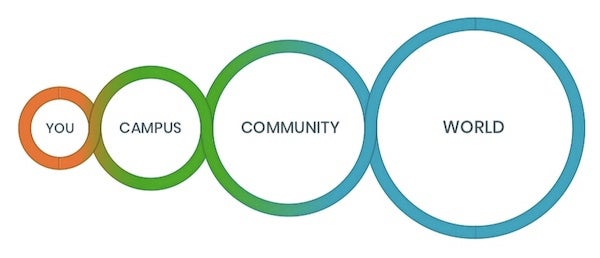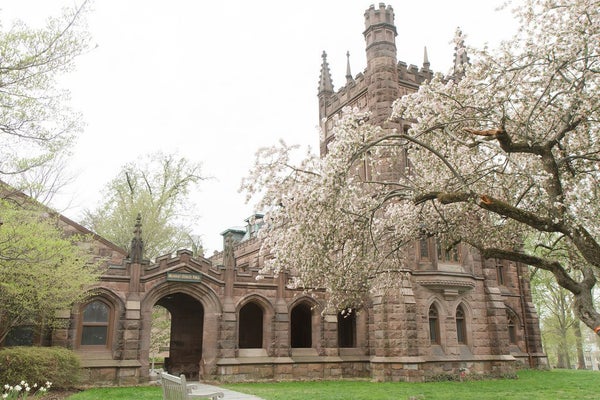This article was published in Scientific American’s former blog network and reflects the views of the author, not necessarily those of Scientific American
I had the good fortune to launch Princeton University’s Office of Sustainability in 2006 and help produce its first comprehensive sustainability plan a year later. We were then clearly in the “growth of campus sustainability” phase. This year, we have released Princeton’s second comprehensive Sustainability Action Plan.
As sustainability and climate action becomes a rallying cry for young people around the world, thousands of colleges and universities have become the testing ground for grappling with real-time changes that deeply challenge how we’re used to going about our business. There are many encouraging stories of successful transformation, but there are also deeply entrenched (and often unconscious) habits that feel immovable. This sustainability endeavor, which demands evidence-based rigor but with no single “right” answer, enhances critical thinking, teaching and research environments, and tests potentially scalable and repeatable strategies for broader use.
The burgeoning global activism comes at a time of dramatic growth in the number of campus sustainability offices or their equivalent; perhaps a reflection of mounting societal alarm in the face of inaction at national levels. In 2017, more than 450 dedicated sustainability positions were in place in the U.S. and Canada, up from 36 in 2005.
On supporting science journalism
If you're enjoying this article, consider supporting our award-winning journalism by subscribing. By purchasing a subscription you are helping to ensure the future of impactful stories about the discoveries and ideas shaping our world today.
Many of these programs are continuing to grow as their cross-disciplinary and applied collective action models prove more and more effective in changing attitudes and habits toward regenerative decision-making. Regenerative, in this context, refers to not just the “sustaining” of earth life support systems and species, but active human participation in the self-healing potential of nature. I and many of my colleagues find the word “sustainability” to be an unsatisfying reflection of the work. What we do is more accurately a craft of aligning human ways of doing things with actions that enhance the productivity and vitality of natural systems.
Each campus, like each town, has its own strengths and character. Each has its unique way of approaching global challenges as they manifest locally, with solutions shaped by its specific culture and context. While the overarching issues are global—disruptive weather patterns, loss of biodiversity, food insecurity, lack of infrastructure resilience, rising sea levels, social and environmental injustices—the many emerging creative and innovative solutions are often necessarily informed by local conditions. Some of those local conditions are common across regions or types of institutions, so the evidence-based solutions in one setting are promising candidates for replication in others.
A few weeks after our second plan’s April 2019 release, I spoke with a group of students in an upper-level undergraduate engineering class entitled “Energy for a Greenhouse-Constrained World.” I was there to share the details behind Princeton’s newly declared target of net zero greenhouse gas emissions by 2046, the institution’s 300th anniversary, and ambitious targets in other areas. By the end of the conversation, I was reminded of a very important lesson that speaks to the fundamental intent behind this milestone plan—an intent less to convey information than to encourage changes in behavior (which is why we call it an action plan).
One student said that after hearing about the years of coalition-building, leadership cultivation, amassing of evidence, and community-generated decision-making, he had an appreciation for Princeton’s commitment that he didn’t have before. He lamented that more students didn’t know what he now knew. It was clear to me that he felt emotionally connected because I was able to share my personal experience with what was, at its core, a community-building effort. If I had simply outlined the plan, and relied only on charts and graphs, I would have failed to make a critical human connection with these students. The words on the page would not have been enough to reach beyond an intellectual understanding of its content.
The reminder was that human beings seldom change their minds, their perspectives, or their behavior based on logic or evidence alone. We see this every day in the climate change arena. Few research endeavors have achieved today’s high level of scientific consensus that accelerating climate change is human-caused. But overwhelmingly substantiated evidence has not yet been enough to spur widespread changes in behavior. Changes in behavior seem to require a more robust recipe—with ingredients that go beyond facts and figures, and have something to do with meaningful personal experiences in the context of community.
I see the power of community, or lack thereof, play out every day in my work. A memorable recent example grew out of developing a step-by-step playbook for how to operate more sustainably in a typical administrative office. In the course of that exercise, we identified a barrier to using reusable cups, plates and utensils instead of disposables: this particular office had no good way to wash anything. What we failed to appreciate initially was that the seemingly simple solution of installing sinks or a dishwasher quickly unleashed concerns about who would be saddled with cleaning the dirty items generated by guests.
This focus on inconvenience and, for some, a perception of unfair burden, clearly outweighed any concern about the global impact of single-use disposables in our oceans or microplastics in our bodies. More generally, it was a reminder that making it possible for people to do something is not the same as making them want to do it. Abstract global concerns quickly give way to immediate, tangible and personal concerns. What was missing was a personal experience or connection with the issues, or a meaningful bond with a community that shared concerns for the issues.
In another office, the same infrastructure barriers existed, but several members of that community were passionate about contributing to global solutions via their daily actions. They enlisted their office mates to join them in caring about reducing the volume of waste generated by their events. In this case, enhancing kitchenette features was seen as a way to remove the barrier that was getting in the way of achieving their goals. The benefits they could achieve by adjusting their behavior were more important to them than any perceived inconveniences that might result.
This example illustrates the core intent behind Princeton’s Sustainability Action Plan. The small community described above, and others like it around campus, can create powerful, reinforcing experiences that are meaningful for them, and that serve as examples for others. As they demonstrate new behavioral norms that are no longer perceived as inconveniences, it makes it easier for others to consider doing the same. Demonstrating that you are enthusiastically part of the solution can be contagious.

Credit: Office of Sustainability, Princeton University
Any endeavor that requires a change in habits and behaviors requires diligence and sustained attention. The publication of a plan is a snapshot of a moment—a picture of the top of the mountain, rather than the map to get there. It takes years to complete the climb, with fits and starts along the way. We need to be clear about what the journey will require, even as we point out as compellingly as we can why it is so important that we all join together in trying to get to our destination.
I’ll use myself as an example. I am in the sustainability profession, and I make personal choices that are informed by that work. And yet, early in my career, it took me years to remember consistently to take reusable bags when I went to the store. It seems like such a simple thing, but the human brain is wired to do as much as possible on auto-pilot, and once an action gets slotted into that auto-pilot groove, it takes effort (or dire emergency) to shift it into a different groove. It was a huge relief to me when the “Don’t forget your reusable bag!” signs started showing up in parking lots.
Then I took only a few steps from the car before I realized I had forgotten, rather than groaning with frustration once I was already in the store. Soon after that the habit was ingrained, and I started remembering without relying on the signs. Now I realize that, psychologically, the signs removed the mental burden of having to remember, and thus removed a significant barrier to a new behavior that I wanted. Those signs were the perfect nudge for me, and hopefully for many others. Now I don’t even have to think about bags—bringing them along is in the autopilot groove.
We need sustainability plans because as a species we are not yet on autopilot when it comes to decision-making that takes honest account of current and anticipated global conditions. These plans express our aspirations, send strong signals about emerging new social norms, and can provide platforms for removing behavioral barriers and developing behavioral nudges.
They, along with global frameworks like the UN Sustainability Development Goals, are also important platforms for discussion with the youth of the world, and for action. Young people, more than anyone, can and will help accelerate meaningful action toward the regenerative visions represented there. In my view, offices of sustainability all across higher education will serve, more so than ever, as extraordinary resources on this collective journey.
For a well-compiled history of the evolution of sustainability in higher education institutions (HEIs), I recommend the 2018 review Campus sustainability in the US: Environmental management and social change since 1970” by Washington-Ottombre, Washington and Newman. The authors outline three development phases, starting with “greening the campus” from the 1970s to the 1990s, the “growth of campus sustainability” from the 1990s to the 2010s, and the current phase, “transforming HEIs to implement sustainability on campus and beyond.” The field has now matured such that we can explore how to scale and replicate the lessons learned from decades of campus-based tinkering and investigation.
